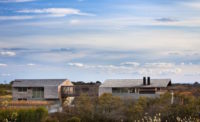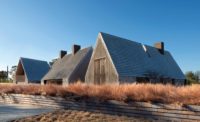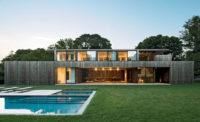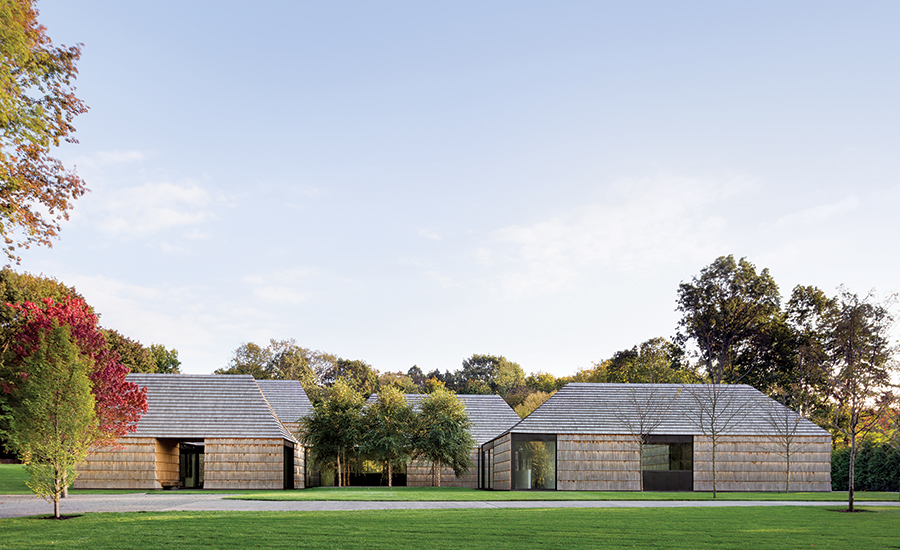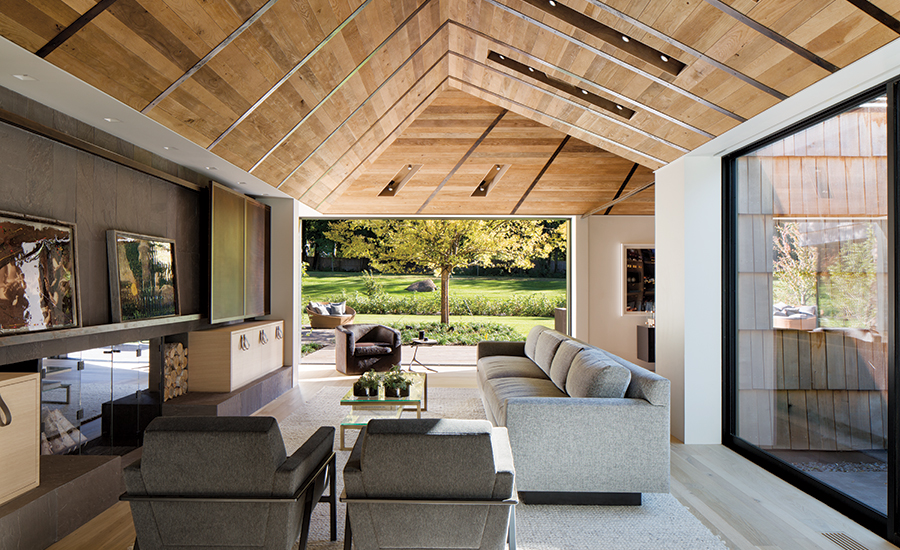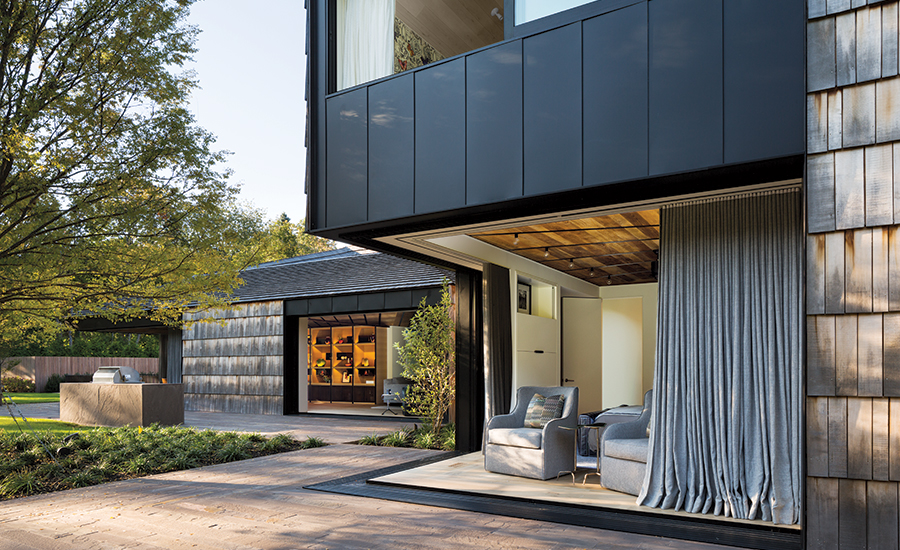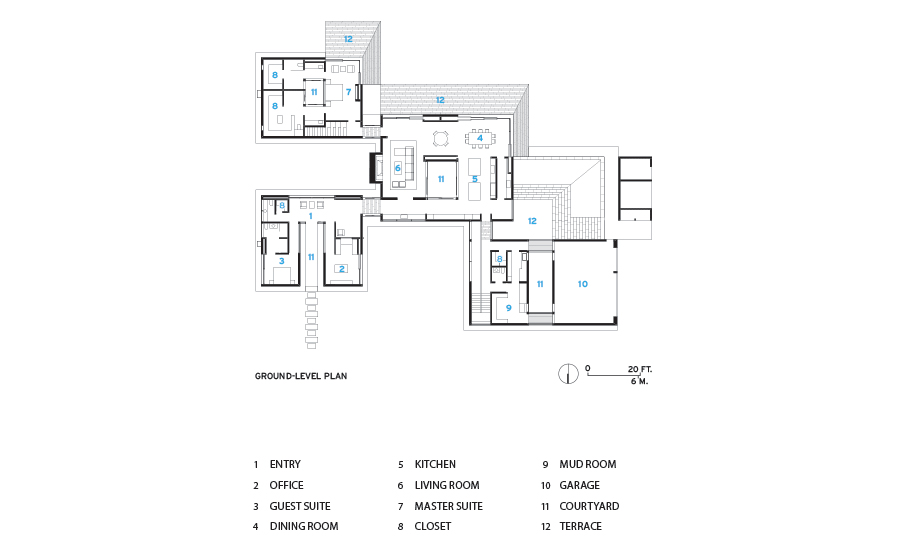Underhill House by Bates Masi + Architects
Matinecock, New York

Situated on a three-acre corner plot with neighbors in close proximity, the house comprises four distinct structures connected by interior passageways.
Photo © Michael Moran / Otto

The living room opens fully to the backyard when an operable glazed wall recedes.
Photo © Michael Moran / Otto

A sunken courtyard allows light to reach below-grade rooms.
Photo © Michael Moran / Otto

Large works of art are found throughout the house, including a portrait by Raphael Mazzucco in the entryway that provides a focal point for the long hall.
Photo © Michael Moran / Otto

Photo © Michael Moran / Otto

Two islands—one stationary, the other on castors—anchor the large, airy kitchen.
Photo © Michael Moran / Otto

That space flows to the dining room and, when the glazed walls there are opened, to the lawn.
Photo © Michael Moran / Otto

The architects fashioned a bench from walnut wood—the same wood used in the cabinetry—for a courtyard just beyond a seating area near the house’s main entrance.
Photo © Michael Moran / Otto

The corner of the master suite dissolves into the landscape when the two glazed walls are withdrawn.
Photo © Michael Moran / Otto

The buildings’ roofs, which dip down toward the atriums, are lower on the sides facing the south lawn, maximizing privacy and capturing sunlight.
Photo © Michael Moran / Otto

Image courtesy Bates Masi + Architects

Image courtesy Bates Masi + Architects












Architects & Firms
Three years after working with Bates Masi + Architects on a vacation home in Montauk, New York, Rick and Alicia Scanlon returned to the East Hampton–based firm to design a primary residence for their family of five, farther west on Long Island. They desired a location that would offer good schools and other conveniences of suburban life but also easy access to New York City. The couple selected a three-acre site in Matinecock, New York—a small residential community with 18th-century Quaker roots, in the Town of Oyster Bay. “I wanted to be right in the village,” says Alicia. “Not way down a winding road.” The property is also situated less than a mile from the Friends Academy, where their three children attend school.
In spite of its being entirely new construction, the house manages to blend seamlessly into its context on a residential street in close proximity to existing homes. “The first thing we wanted was to make sure we were sensitive to the neighborhood,” says Alicia. “I didn’t want to overbuild.” In that vein, the clients also requested spaces that they would regularly occupy; there would be no formal parlors here. “We dissected the typical residential program and deciphered what they really needed,” says firm partner Paul Masi, who led the design of the 6,300-square-foot project. “They use every inch of it.”
Taking cues from older structures in the village, the house is clad in cedar shingles, weathered to a cool silver gray. Bluestone cut to similar dimensions as the shingles provides visual continuity as paving and cladding on below-grade areas. “I wanted it to be very subtle,” says Alicia.
The family, who had lived in Singapore for more than 15 years prior to returning to the States and settling in Long Island, desired the new steel-frame building to be a welcoming space, suitable for entertaining. It also would evoke their former home in the tropical island nation by blurring the line between indoors and out. Masi conceived of the residence as a group of four separate but interconnected pavilions. At the heart of the cluster, the largest volume provides ample space for eating, entertaining, and relaxing. Family bedrooms are located in a second structure, including the parents’ double-bath suite—complete with a private atrium—and children’s rooms above, accessible via a stadium stair. Another section includes a guest suite and offices, while the fourth contains service areas, the garage, and a basement where a gym and game room lead out to a sunken terrace.
The architects placed courtyards, open to the sky, at the center of each space in order to funnel natural light into all sections of the house. The roofs around these insertions, which are higher on the north, street-facing side to retain privacy, take the form of an abstracted gable, recalling the shape of nearby buildings. Generous floor-to-ceiling glazing around the atriums and on select walls permits views across and through the residence. “The courtyard breaks it up just enough so there’s some privacy, but I can still sort of sense where everybody is,” says Alicia. Most of the window walls are operable, sliding into deep pockets. “They open up and, suddenly, you’re in a landscape,” says Masi. Buttjointed glazing maintains this effect even when the windows are closed.
In deferring to the local vernacular, the architects emphasized the multifaceted character of natural and industrial materials. A restrained palette and sense of craft unify the diverse spaces of the house: oak boards line not only the floors but the ceilings and underscore the rectilinear geometry of each volume. Decorative metal straps, fastened across the wood staves overhead, like hoops on a wine barrel, radiate across the planks. Built-in storage throughout the main level has weathering-steel screens, picking up the thread of rustic metal, and outside, the design team used the same wood as the cabinets’ to create a bench, nestled among a narrow grove of trees. “It’s an interesting pursuit to see what the character of a material is and what its capabilities are,” says Masi.
The Underhill House provided the architects with the refreshing opportunity to create a year-round residence, rather than the weekend houses for which the firm is particularly known. Balancing the need for both privacy and spaces that bring the family together on a daily basis, the design reflects the clients’ vision for a good home life. Says Masi, “It’s a place for people who really live here.”
CreditsArchitect: Bates Masi + Architects— Paul Masi, design partner; Katherine Dalene Weil, Emily Ko, project architects; Victoria Pryor, interior designer
Engineers: Steven L Maresca
Landscape: TL Studio
General contractor: Qualico Contracting
|
SpecificationsMasonry Tompkins Bluestone Locksets Emtek, Linnea Paints and stains Benjamin Moore Solid surfacing Corian Cabinets and custom woodwork Ciuffo Cabinetry Outdoor seating B&B Italia Lighting Cooper Lighting, Delta Light, Element Lighting, Lutron, Sonneman Plumbing Cifial, Kalista, Newport Brass |

